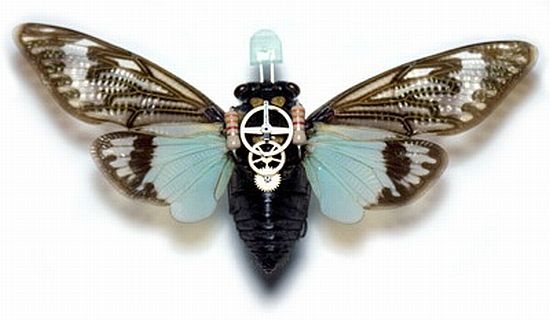
For years, now, Pentagon-backed researchers have been trying to create cyborg insects that could serve as living, remote-controlled spies. The problem is, those modified bugs never survived long enough to be useful. Now, Georgia Tech professor Robert Michelson says he’s managed to get the bug ‘borgs to live into adulthood.
DARPA’s Hi-MEMS program aims to implant place micro-mechanical systems [MEMS] “inside the insects during the early stages of metamorphosis,” the agency explains. That way, as the bugs get older, tissues grow around — and fuse together with — the tiny machines.
Flight International reports that, in his latest work, Michelson truncated a Manduca moth’s thorax “to reduce its mass.” Then he put in “a MEMS component… where abdominal segments would have been, during the larval stage.”
Images taken by x-ray of insects with these changes and others found that tissue growth around the inserted probes was good. One DARPA goal is to show that during locomotion the heat and mechanical power generated by the thorax could be harnessed to power the MEMS.
Ultimately, DARPA wants these MEMS to remote-operately the insects, either through “direct electrical muscle excitation, electrical stimulation of neurons, projection of ultrasonic pulses simulating bats, [or] projection of pheromones,” the agency says. The ultimate goal would be to have the cyborgs “carry one or more sensors, such as a microphone or a gas sensor, [and] relay back information.”
The realization of cyborgs with most of the machine component inside the insect body will provide stealthy robots that use muscle actuators which have been developed over millions of years of evolution.
The cyborgs also offer unparalleled opportunities for lab workers to shout, “It’s alive! It’s aliiiiiiiive!!!”
ALSO:
- How To: Make a Robotic Insect
- Plasma Propulsion for Palm-Sized Drones
- Miami Police Enlists Drone
- Video: Dragonfly Drones in Flight
- Video: Creepy, Crawly Hybrid Flying Drone
- Insect Drones ‘Spotted’ on US Streets
- Beamed Power For Dragonfly Spies
- British Police’s New Spy Drone
- Air Force’s Mini-Drone Swarm
- Air Force: Bug-Like Robo-Bombs for Indoor Ops
- Bug Eyes, Bat Ears for Mini-Drones
- Mini-Drone Vs IEDs
- Video: Bio-Bots Slither, Creep, and Waddle Ahead
- Area 51’s Robotic Spy Bird
- DARPA’s Sex Slave Insects
- Robo Fly, Built to Spy
- Robo-Critter for River War
- Military Cyborg Menagerie
- Cyborg Flying Rats Invade China
- Cyborg Pigeons Revealed!
- Drone Dog’s Big Walk
- Video: Robo-Mule, Remixed
- New Video: Robotic Pack Mule Leaps Into Action
- Mobile Robots Take Baby Steps
- New Video: Robo-Mule Conquers Ice, Snow
- Monkey Brain Controls Walking ‘Bot
- Monkey Mind-Controlled Robot: The Video
By Noah Shachtman
lMarch 19, 2008 | 7:44:00 AM
Source: Wired